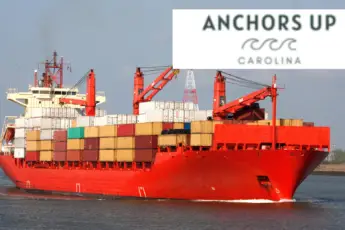While operating vessels offshore, I have encountered many ships either at anchor or underway. Undoubtedly, it is hard to imagine how freighters of that size are capable of remaining afloat. The combination of the height, length, width, and weight would seem as though it would sink to the bottom. However, when all of the above are added together, they are challenged to slow and stop. Remember, ships are not equipped with brakes. Here is how an ocean freighter slows and stops in an emergency.
Why Do Ships Need To Slow And Stop Abruptly
Without question, it is not common for a ship to face an issue where it is required to slow and stop abruptly, but it can happen. Fortunately, as a captain, I have never encountered this type of situation. Here are the primary reasons that ships must stop quickly.
They Are Encountering An Unsafe Passing Situation
One of the primary reasons that ship operators are required to slow and stop a vessel is when they are attempting to avoid collision with a passing vessel.
Unfortunately, maritime accidents do occur, especially when there is low visibility. However, with an AIS system, the risk is significantly reduced.
A ship’s captain or officer may need to stop the freighter abruptly in the event they are at risk of a collision.
Power Failure
One of the most frightening scenarios is a power failure, whether it be an engine or an entire ship blackout.
I have been on board yachts that have encountered blackouts and never leave you with an easy feeling.
In the situation where a ship encounters a blackout or engine failure, they are in a dire situation especially when near the shore, in rivers, bays, sounds, and ports.
Without question, one of the biggest fears of a captain is facing a blackout or engine failure in congested areas. This is ranked closely to dealing with an onboard fire.
Unfortunately, the operator must avoid disaster in unconventional ways when this type of scenario occurs.
How Do Ships Slow And Stop
Unquestionably it is essential to consider the momentum a ship carries when combining the size and weight. An ocean freighter can take miles to stop, especially when operating at cruising speed. However, keep in mind that a loaded ship will require the most time compared to an empty freighter. Here are the primary ways that captains and crew slow and stop ships when facing an emergency.
Putting The Engines In Reverse
One of the primary reasons for this is that ocean freighters are slowed and stopped during an emergency by putting the engines in reverse.
The reverse thrust will apply force in the opposite direction of the ship’s momentum. Although the freighter won’t stop instantly, it will shorten the time span between for it to come to a complete stop. Keep in mind, this is not an option if the vessel faces engine failure or a blackout.
Lastly, despite a ship applying reverse thrust, it may not be enough time to avoid a collision with a fixed object or vessel. However, it may lessen the impact as a result of colliding.
Dropping The Anchors
A last-ditch effort is dropping the anchors in an effort to avoid disaster. In some cases the decision will be made to drop anchors no matter if the ship lost power or not.
Dropping the anchors is a last-ditch effort to slow and stop a ship in imminent danger of collision.
The decision to drop the anchors is necessary when it is clear the vessel is incapable of stopping in time.
Importantly, the purpose of deploying the anchors is to create drag. The drag is created by the anchor chain and anchor in open and deep waters. However, in shallow waters, the seabed provides additional stopping power when the hooks drag along the bottom.
Remember, despite dropping the anchors, a ship will not stop instantly. Instead, it will carry momentum for an extended period of time.
Lastly, this type of collision avoidance method is not commonly used. This is when the ship and other objects, ships, or people are at imminent risk.
An Ocean Freighter Can’t Slow And Stop Quickly
The next time you gaze at a passing ship from shore or by boat, understand the complexity of making it stop. Without question, ships will continue on for miles despite cutting forward thrust. Unfortunately, this presents a challenge to captains when they lose power or face the risk of a collision. With that said, if you’re a boater, remain clear of ships, as they are not highly maneuverable.



